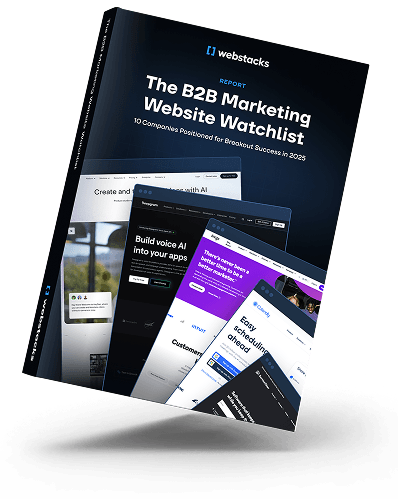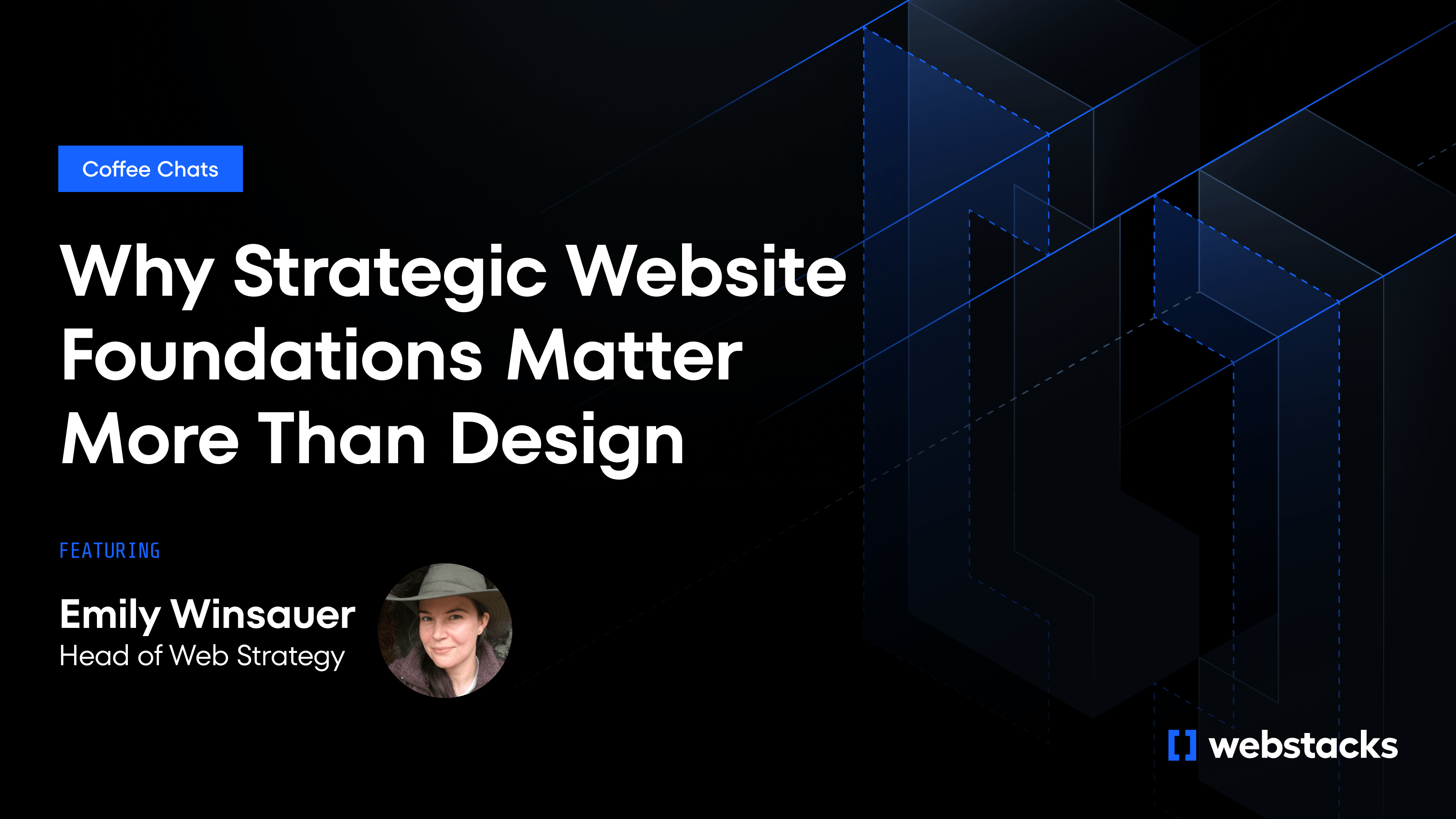Your buyers aren’t just Googling anymore. They’re asking ChatGPT for advice, summarizing your category in Perplexity, and skipping the search results page altogether. If your content isn’t showing up in those AI-generated answers, you’re already losing ground.
That’s why it’s time to rethink how to rank in GPT search for B2B companies. Traditional SEO tactics, such as keyword stuffing and thin, low-value content, are no longer a good idea. GPT-powered tools prioritize clarity, credibility, and content that solves real problems. If your site isn’t structured to support that, it won’t get pulled into chat responses.
At Webstacks, we help B2B teams build websites that aren’t just fast — they’re built for how AI models find and extract answers. Because in this new environment, your site is your data source. Whether you surface in GPT search depends on how you communicate what you do and who you help.
This article breaks down what GPT search prioritizes, how to create content it can use, and why your site structure matters more than ever.

1. Write for Use Cases, Not Search Terms
Most B2B teams still build content around keywords. But GPT search doesn’t work that way. It’s trained on language patterns, not keyword density. What matters isn’t whether your page includes “onboarding automation software”, but if it helps a RevOps leader figure out how to reduce onboarding time without adding headcount.
The shift here is subtle but important. Instead of asking, “What search term are we targeting?” ask, “What problem is this page solving, and who’s trying to solve it?” That mindset leads to content that’s far more useful and more likely to be surfaced in GPT responses.
Use case-driven content also makes your site easier to scale. When each page is tied to a specific scenario, role, or job-to-be-done, it becomes easier to map, link, and for AI to parse.
Tools like AlsoAsked and even ChatGPT itself can help you uncover real questions your audience is typing into AI. Use those prompts to shape headlines, intros, and supporting paragraphs. The goal is to become the source that answers the question.
2. Structure Content for Machines and Models
GPT engines don’t browse your site like a person. They scan for structure and focus on elements such as:
- Section headers
- Semantic HTML
- Consistent naming
- Internal relationships
If your content isn’t organized clearly, it won’t get used, no matter how smart the copy is. Start with your page layout. Every section should have a clear purpose, starting with descriptive H2s and H3s that mirror real prompts.
Avoid clever or abstract headers. GPT models look for context they can reuse. For example, “How product marketers can launch faster” or “Ways to reduce churn without more headcount.”
Break up long explanations into short, focused sections. One topic per paragraph. One idea per heading. This format helps models scan and makes your content easier for human readers to skim, share, and revisit.
Don’t forget about internal links. They help AI models understand relationships between concepts. If you’re talking about “customer onboarding,” link to related use cases such as implementation, activation, or retention. That creates a web of meaning that GPT engines can follow.
Also, don’t skip structured data. Adding schema from Google’s structured data guidelines helps machines identify key details, such as product types, solutions, pricing models, and integrations, without guessing.
3. Prioritize Depth, Not Volume
Most GPT engines are trained to skip over generic content. That’s why surface-level blog posts, especially the kind written just to hit a keyword, are getting filtered out.
What works instead is deep, specific content. Focus on explaining something your audience actually needs to understand. Go beyond what and start showing how. Walk through real frameworks, decisions, or tradeoffs that someone in a buying role would be evaluating.
This doesn’t mean longer is better. It means each section should do real work. If you're writing about how to reduce implementation friction, show the steps. If you're comparing integration models, lay out the pros and cons — not in general, but for the teams that will be using them.
Language matters here, too. Use terms your buyers use. Talk to RevOps, demand gen, or product marketing teams in their own words. Mention tools, processes, and blockers they’ll recognize. That’s what GPT engines look for — proof that you understand the problem and can explain the solution clearly.
Also, instead of writing more posts, write better ones. GPT will pull from the pages that do the most explaining, not the ones that publish the most frequently.

4. Optimize Your Site’s Technical Foundation
Even the best content won’t show up in GPT search if your site isn’t crawlable, fast, and structured. These engines rely on clean HTML, consistent metadata, and strong internal signals to understand what your site is actually about.
Start with performance. Slow sites get ignored by users and models alike. Use tools like PageSpeed Insights to catch issues with load time, layout shifts, and responsiveness. Fixing these issues improves the user experience (UX) and increases your chances of being indexed and surfaced by AI tools.
Next, focus on structure. Every page should use semantic HTML. Focus on:
- Clear headings
- List items
- Logical sectioning
Add schema markup where it makes sense. You can start with basic structured data for articles, products, or FAQs. It helps models tag and interpret your content more accurately.
Navigation also matters. GPT engines follow links to understand how topics relate. If your site buries important content or uses vague page names, you’re making it harder for any AI system to map your expertise.
Also, if your site still runs on an outdated CMS or bloated front-end framework, now’s the time to rethink it. A fast, composable setup improves crawlability and gives your team more control to ship updates quickly.
For teams planning a replatform, Webstacks’ website migration services are designed to ensure that technical performance and structured content stay at the center.
5. Monitor What GPT Is Already Saying About You
If you want to rank in GPT search, start by checking whether you’re already showing up. The fastest way to find out? Ask the tools directly. Run prompts in ChatGPT, Perplexity, or Gemini that reflect what your buyers would search. Then see if your company, product, or resources make the cut.
Start simple. Try questions like:
- “Best onboarding software for mid-market teams”
- “How to improve retention without expanding headcount”
- “What tools do RevOps teams use for activation?”
If your brand appears, analyze what content the model is pulling from. Is it current? Accurate? Specific? If not, you may need to update those pages with clearer structure, tighter explanations, or more relevant examples.
If you don’t appear at all, look at who does. Study how their content is framed. Often, it’s not that they published more — it’s that they answered the question more directly.
You can also use tools like Perplexity.ai to trace citations. These systems show where their responses come from, so you can see which parts of your site are getting recognized and which ones are invisible to AI.
The goal is both visibility and influence. You want GPT engines to pull from your best content, not from competitors who explain your category better than you do.
Build for Recognition, Not Rankings in GPT Search
GPT search doesn’t care how many keywords you’ve used or how often you post. It surfaces content that’s clear, authoritative, and genuinely helpful. For B2B teams, that means shifting away from generic SEO tactics and toward structured, use-case-driven content that mirrors how buyers actually think.
If your site is slow, cluttered, or built around outdated assumptions, AI models will overlook you. But if your content is specific, well-organized, and tied to real buyer questions, you’re already ahead.
At Webstacks, we help B2B companies redesign and rebuild their sites to support speed, scale, and performance. Whether you're refreshing your content model or planning a full site migration, we make sure your website is ready for how people, and AI, search today.
Want your company to show up where decisions actually happen? Let’s build a system that gets you there.




